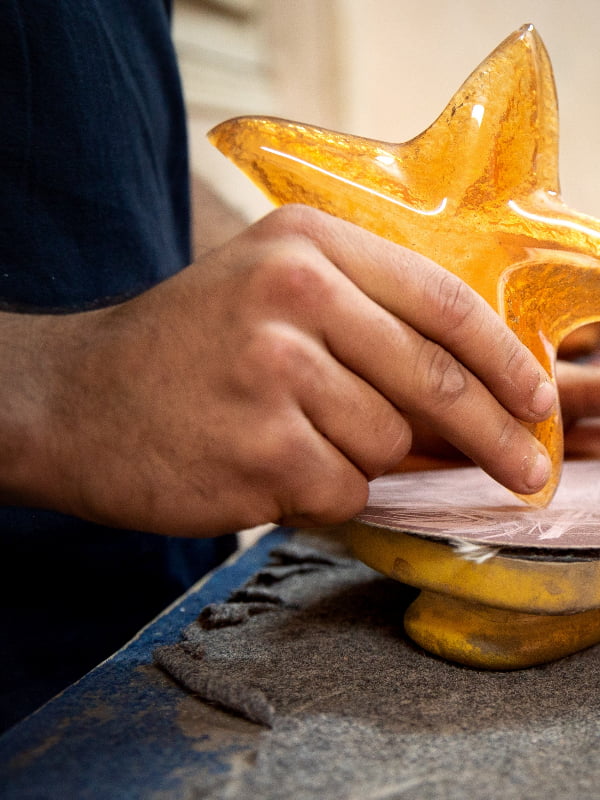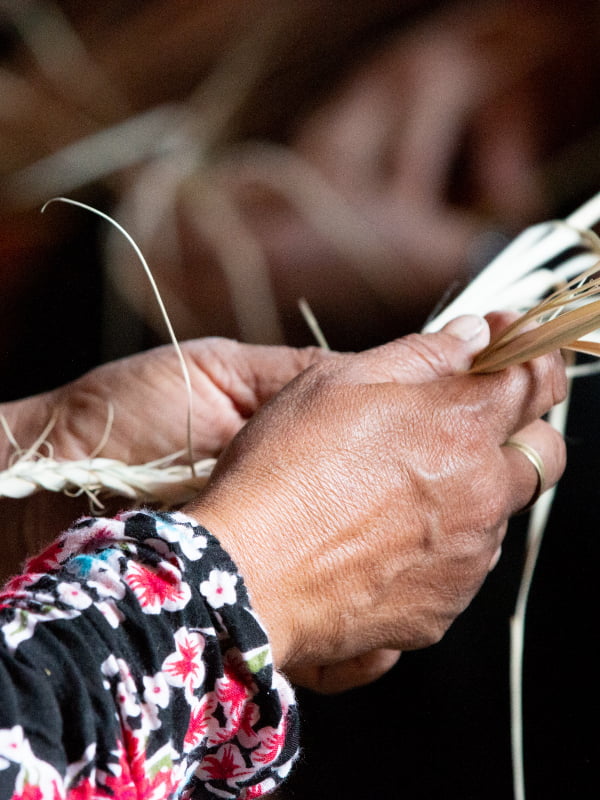The Living Wage: a Way Out of Poverty
Millions of people worldwide are poor, even though they have a job. Having a job that pays a wage is not always a way out of poverty. The common term for this phenomenon is 'labour poverty'. Do you own a Dutch company? Do you buy your products in another country, or are they made in another country? Do you know if the employees in your production chain earn a living wage? Read on to learn more about the living wage and how you can help from the Netherlands. We can help you with knowledge, insights and advice.
What is the living wage?
The Anker Methodology for Estimating a Living Wage describes the living wage as "remuneration that a worker receives for a standard workweek. This wage is enough for the worker to afford a decent standard of living for themselves and their family. Elements of a decent standard of living include food, water, housing, education, health care, transport, clothing, and other essential needs, including savings for unexpected events."
The Global Living Wage Coalition (GLWC) uses the Anker methodology as a recognised standard. The GLWC offers objective and high-quality information about liveable wages and wage differences. Organisations use this information to create strategies and programmes to increase wages.
What is the difference between the minimum and the living wage?
The minimum wage is the minimum amount of money that an employee must receive for their work. The law says how much this is. The minimum wage is lower than the living wage in many producing countries. Employees in these countries do not earn enough money to live off or care for their families.
How much is the living wage?
The living wage varies from country to country. This is because of the vast economic differences between countries. There are differences within countries, such as between cities and the countryside. It is also difficult to compare social situations. Here is an example. The average family in the Netherlands has 2.2 members, but the average family in Senegal has 11.6 members. Still, most employees in Senegal earn enough to care for many children and their parents. This shows that the living wage in one country does not have to be the same as in another.
In Ghana, the gross living wage is USD 2.08 a day. In Côte d'Ivoire, this is USD 2.55 a day. In the Netherlands, the gross living wage is €79.62 a day.
Do you want to find out the living wage in a country? WageIndicator has calculated this for many countries. For more information, see the WageIndicator's webpage 'Living Wages for Workers, Employers and Trade Unions'.
The Global Living Wage Coalition also provides information. See their webpage 'Salary Checks - World Wide Wage Comparison'.
In many developing countries, the minimum wage is lower than the living wage. There are several reasons for low minimum wages:
- Employees in low-wage countries often read poorly or not at all. This is mainly true for those who do unschooled manual work. They know little about their rights.
- There are few checks on employee rights and working conditions. This puts employees at risk of exploitation.
- Employees can quickly lose their jobs if they have to take time off work or become ill.
- Most employees are paid daily. They earn hardly any extra money or days off for working overtime.
- Jobs are scarce in low-wage countries, so many people apply for the same job.
- Because so many people want to work, the work pays little.
- In many developing countries, the minimum wage has not increased for years. At the same time, the value of money has decreased.
- Low wages make a country a more attractive place to produce. Many governments believe their country will benefit from cheap production.
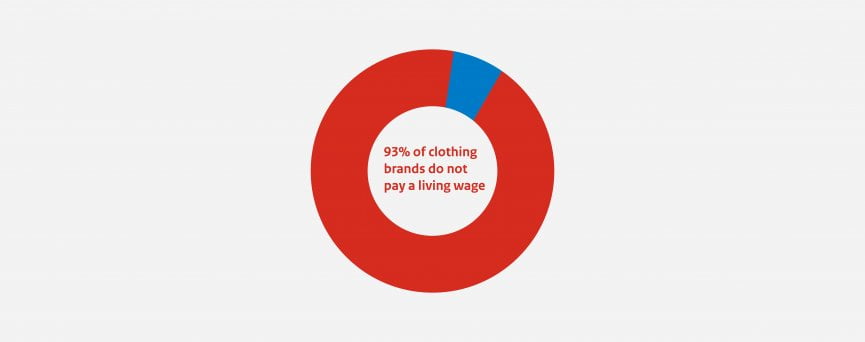
93% of clothing brands do not pay a living wage.
Employers can increase the wages of their employees, of course. But then there is a risk that production will become too costly. Companies then risk losing contracts to competitors. Higher wages often mean higher prices. When this happens, buyers look for other, cheaper producers. As a result, production moves to countries with even lower wages.
Here is an example. In Bangladesh, wages went up from 5,300 taka (€56) to 8,000 taka (€84) a month in 2018. Afterwards, many textiles and clothing brands moved their production to Ethiopia and Myanmar. In the clothing industry, living wages are rare as clothing brands want to stay competitive. The combination of low prices and no living wage leads to underpaid employees in the supply chain.
What is the difference between the living wage and the living income?
The living wage is not the same as the living income. In both cases, it is about the money someone earns. But the living wage is for people in paid employment, for example, in a textiles factory or on a sugar cane plantation. The living income is for self-employed people, such as coffee or cocoa farmers.

In Bangladesh, the living wage is 7.25 euros per day. But, the average wage is 3.58 per day.
Is a living wage a human right?
Yes, a living wage is a human right. Article 23(3) of the Universal Declaration of Human Rights says, "Everyone who works has the right to just and favourable remuneration, ensuring for himself and his family an existence worthy of human dignity, and supplemented, if necessary, by other means of social protection."
The Sustainable Development Goals (SDGs) are the 17 development goals of the United Nations (UN). These goals aim to make the world a better place. They focus on how to solve poverty, education inequality and the climate crisis. The UN member countries have agreed to work together to achieve these goals by 2030. The Netherlands is one of these countries.

The world population will grow from 7.5 billion (in 2020) to 10 billion (in 2050).
What is the link between the living wage and poverty?
Labour poverty is about more than money worries. Is the wage for an average working week not enough to meet the basic needs of the employee and their family? Then there will be other poverty-related problems. These include poor health because of a poor diet and limited access to good health care. Other problems include a lack of social security, poor housing, limited access to education and exclusion from cultural and political life.
Where are wages lowest?
All over the world, wages are lowest in the clothing and textiles industries. There, the average wage is USD 3.90 a day. Another industry in which employees earn low wages is the food industry. Examples are the banana industry (USD 9.90 a day in Costa Rica), the cocoa industry (USD 1.23 a day) and the sugar cane industry (USD 4.27 a day).
In Bangladesh, employees earn a gross wage of €3.58 a day. The gross living wage there is €7.25 a day.
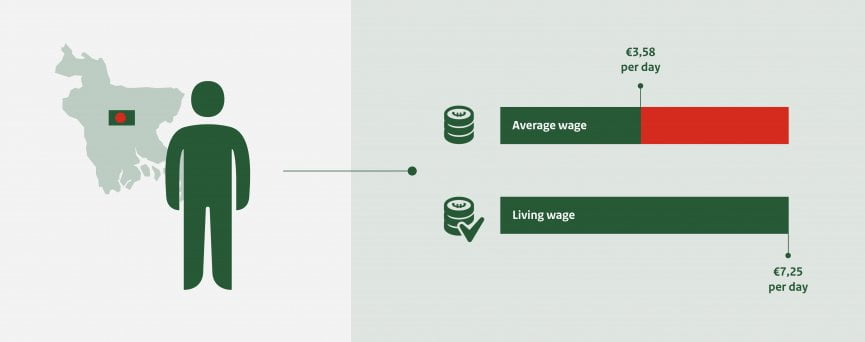
In Bangladesh, the living wage is 7.25 euros per day. But, the average wage is 3.58 per day.
Which industry has the biggest gap between the minimum and the living wage?
According to the Asia Floor Wage Alliance, the gap between the minimum wage and the living wage is the biggest in Bangladesh:
| Bangladesh | Sri Lanka | China | Indonesia | |
|---|---|---|---|---|
| living wage | 7.63 US$ | 26.30 US$ | 24 US$ | 13.38 US$ |
| minimum wage | 3.76 US$ | 5.27 US$ | 12.72 US$ | 20.27 US$ |
We used a 6-day working week to convert the weekly amounts into daily wages.
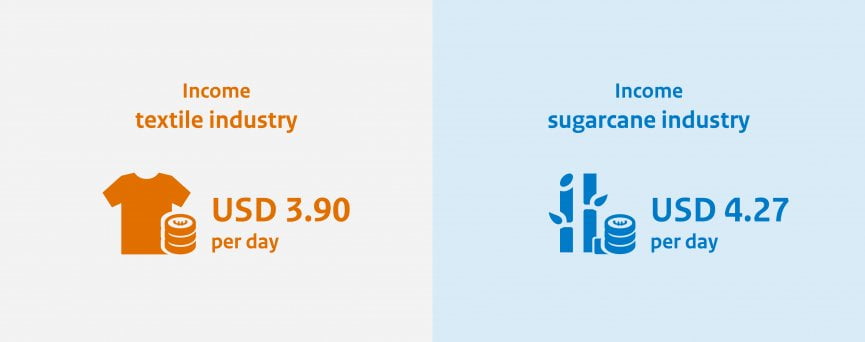
Someone in the textile industry gets paid 3.90 US dollars per day. Someone working in the sugarcane industry gets paid 4.27 US dollars per day.
How does the living wage help countries produce sustainably?
The first step in sustainable production is the creation of the product. Companies need to have several things in place for sustainable production. This includes a healthy working environment and favourable wages to meet the basic needs of employees.
Sustainable production and consumption, and more efficient use of resources, is one of the Sustainable Development Goals (SDGs). This is SDG 12. The Netherlands is working with other countries to achieve this goal.
What can companies do to pay a living wage?
Companies can take action to help pay the employees in their supply chain a living wage.
Companies in the banana industry have already taken important steps towards a living wage. In 2019, many Dutch supermarkets signed an agreement to work together to pay banana pickers a living wage. Their goal was to reduce the minimum wage and living wage difference by at least 75% within 5 years. This agreement shows that supermarkets are willing to make their production chain more sustainable.
Eosta, a distributor of organic fruits, is also working on a solution. It already supplies 3 living wage products to shops. They are mangoes from Burkina Faso, avocados from Kenya and passion fruit from Peru. Examples like this prove that a solution for the whole chain can be effective. The fruit and vegetable industry can be an example to other industries that have not yet made progress. Think of the textiles, sugar and electronics industries.
What can Dutch companies do to pay a living wage?
Many companies in the Netherlands are working on Responsible Business Conduct (RBC). But how can Dutch companies tell whether their suppliers respect labour laws and international agreements?
Certificates and quality marks are a guarantee to a certain extent. But the difficulty is that most social quality marks only check payments for minimum wages and not living wages. The SA8000 certification scheme is one of the few schemes to only award a certificate to companies paying a living wage. The SA8000 scheme has strict criteria for fair production. Its certification criteria are based on the guidelines of the International Labour Organization (ILO). Some of the criteria are:
- no child labour;
- no forced labour;
- a clean and safe working environment;
- the right of employees to form trade unions and negotiate as a group;
- no discrimination when hiring and promoting employees or offering training;
- treating employees with respect and dignity;
- regular working hours: no more than 48 hours a week, 1 day off every 7 days, no more than 12 hours of overtime;
- employees get a living wage for regular hours and a higher wage for overtime;
- employers are not allowed to withhold payment as punishment.
ISEAL, a global organisation for sustainability standards, also follows the Anker Methodology. The Social and Economic Council of the Netherlands does this, too. It uses the methodology as a living wage guideline for the natural stone industry.
The first step of RBC is that companies are willing to research their production chains. The second step is that they are willing to make changes. Many industries have complex production chains. The product goes through many phases. It is not always obvious what happens during these phases. To find out, companies need insights. Many clothing brands are gathering information to gain insight into their supply chains. The next step is to reduce the difference between the minimum and the living wage in the coming years. Companies can use the insights they have gained to set clear goals.
What questions can Dutch companies ask when researching living wages?
Dutch companies that produce goods in other countries can ask their suppliers:
- for copies of wage slips to compare with the wage slips of educated and uneducated employees. Their auditor can also tell them more about this;
- about the supplier's use of tools, such as those in the Anker Methodology. You can read about the Anker Methodology in the second paragraph on this page;
- how much an average household (5 people) spends on living costs. They can compare this amount with the amount of the wage slip. The Anker methodology mentions the following living costs: food, housing, transport, education, health care and clothing;
- about the supplier's willingness to discuss the living wage also with other buyers;
- are employees allowed to form groups to talk to management about their rights? Examples of groups are worker committees and trade unions. How often do these talks take place?
How can I contribute to a living wage?
You can contribute to a living wage in many different ways. If you have a project idea or would like to get involved in a project, contact our advisors.
Would you like to help raise awareness? Share our user stories and information. For the latest news and user stories, subscribe to our Newsletter. And follow us on social media:
Preventing child labour by providing a living wage in the Côte d'Ivoire cocoa sector
Trading company ETG/Beyond Beans investigates ways to combat child labour in the cocoa sector in Côte d'Ivoire. Together with partners such as Oxfam Novib and support from FBK, the company is working on a living income for cocoa farmers. So that children can go to school and no longer have to work on the cocoa plantation.
- Ministry of Foreign Affairs


